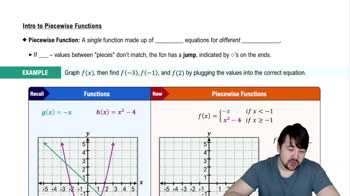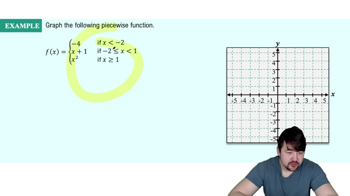Table of contents
- 0. Functions7h 52m
- Introduction to Functions16m
- Piecewise Functions10m
- Properties of Functions9m
- Common Functions1h 8m
- Transformations5m
- Combining Functions27m
- Exponent rules32m
- Exponential Functions28m
- Logarithmic Functions24m
- Properties of Logarithms34m
- Exponential & Logarithmic Equations35m
- Introduction to Trigonometric Functions38m
- Graphs of Trigonometric Functions44m
- Trigonometric Identities47m
- Inverse Trigonometric Functions48m
- 1. Limits and Continuity2h 2m
- 2. Intro to Derivatives1h 33m
- 3. Techniques of Differentiation3h 18m
- 4. Applications of Derivatives2h 38m
- 5. Graphical Applications of Derivatives6h 2m
- 6. Derivatives of Inverse, Exponential, & Logarithmic Functions2h 37m
- 7. Antiderivatives & Indefinite Integrals1h 26m
0. Functions
Piecewise Functions
Problem 89c
Textbook Question
{Use of Tech} Sum of squared integers Let T (n) = 1² + 2² + ... + n², where n is a positive integer. It can be shown that T (n) = n (n + 1) (2n + 1) / 8
c. What is the least value of n for which T(n) > 1000?
 Verified step by step guidance
Verified step by step guidance1
Step 1: Understand the problem. We need to find the smallest positive integer n such that the sum of the squares of the first n integers, T(n), is greater than 1000. The formula for T(n) is given as T(n) = \( \frac{n(n + 1)(2n + 1)}{6} \).
Step 2: Set up the inequality. We want T(n) > 1000, so substitute the formula into the inequality: \( \frac{n(n + 1)(2n + 1)}{6} > 1000 \).
Step 3: Clear the fraction by multiplying both sides of the inequality by 6 to get: n(n + 1)(2n + 1) > 6000.
Step 4: Solve the inequality. This involves finding the smallest integer n that satisfies the inequality. You can start by testing integer values of n to see when the inequality holds true.
Step 5: Verify your solution. Once you find a candidate for n, substitute it back into the original formula for T(n) to ensure that T(n) > 1000.
Recommended similar problem, with video answer:
 Verified Solution
Verified SolutionThis video solution was recommended by our tutors as helpful for the problem above
Video duration:
4mPlay a video:
Was this helpful?
Related Videos
Related Practice





